Amped Wireless R20000G, SR20000G, and UA2000: Routers, Repeaters, and Adapters (Oh My!)
by Jarred Walton on June 23, 2012 12:00 AM EST- Posted in
- wireless
- Networking
- 802.11n
- Amped Wireless
Test Location A Results: Maximum Performance
As described on the previous page, our first location is our best-case scenario with the router and wireless adapters in the same room spaced around five feet apart. No other wireless activity is present on the network, and each test was repeated at least ten times. There’s signaling overhead with all wireless networking, so whereas I’ve seen Gigabit Ethernet hit 115MiB/s (965Mbps, or 96% utilization of the available bandwidth), for wireless networking even 70% utilization of the theoretical bandwidth would be very impressive. We didn’t get anywhere near that, unfortunately, although at least we managed to eclipse 100Mb Ethernet speeds for some of the results.
Before we get to the throughput results, it’s interesting to look at the signal quality with the various adapters and routers. I apologize for the sorting of the charts here, but RSSI is measured in negative decibels, with higher (e.g. closer to 0) values being better. Our graphing engine does weird things with negative numbers, so I’ve dropped the minus sign; the result is that numbers closer to 0 (lower in this case) are better. The second minor complaint with our graphing engine is that with multiple series defined, sorting can be a bit chaotic, so I’ve elected to sort alphabetically by router name on most of the charts you’ll see. Keep in mind that there are two comparisons you can make with each chart: how the routers stack up against one another, and how the wireless adapters fare.
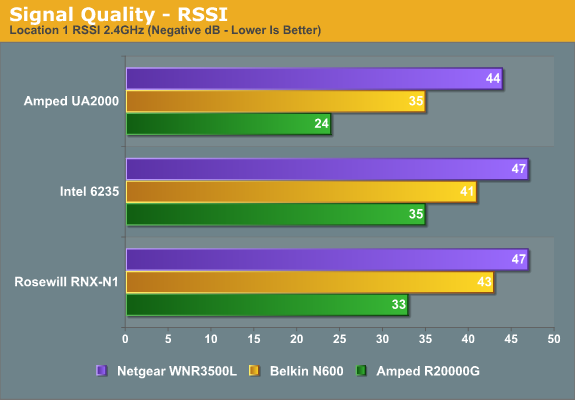
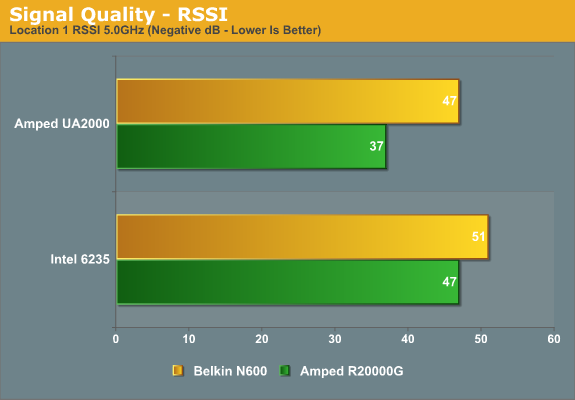
Starting with our first two charts, the Amped Wireless devices score two clear victories. On the one hand, the R20000G router has better RSSI, beating the other routers by anywhere from 4 to 20 dB. (I should note that these RSSI values are approximate, as there’s a bit of fluctuation when measuring with inSSIDer—I took the average RSSI over a one minute period, rounded to the nearest dB.) The second comparison is between the adapters, and again Amped acquits itself well with the UA2000; RSSI is only 3 dB better than the other two adapters when connected to the Netgear router, but it’s 4-8 dB better on the Belkin and 9-11 dB better on the R20000G. If signal quality is any indication of wireless performance, at least at our first test location the Amped router and adapter should have a decent lead in network throughput. We’ll break the throughput measurements into 2.4GHz and 5GHz sections and deal with those separately.
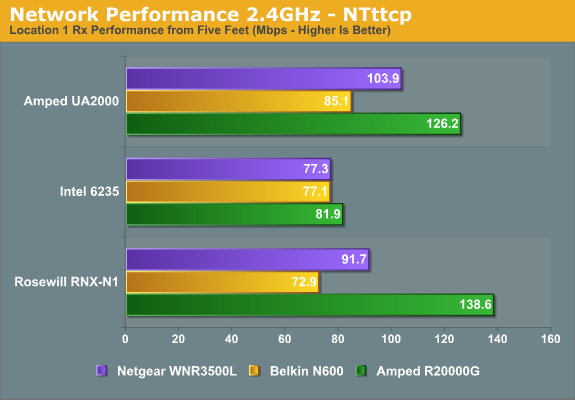
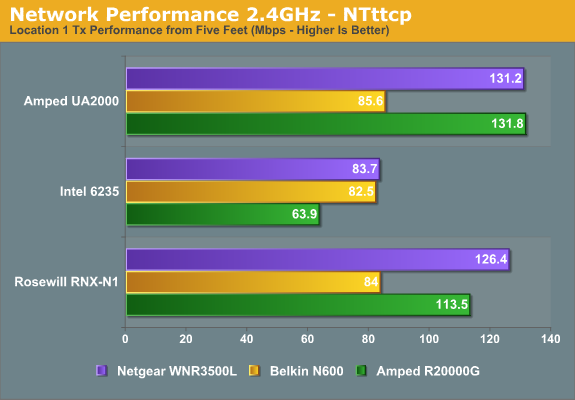
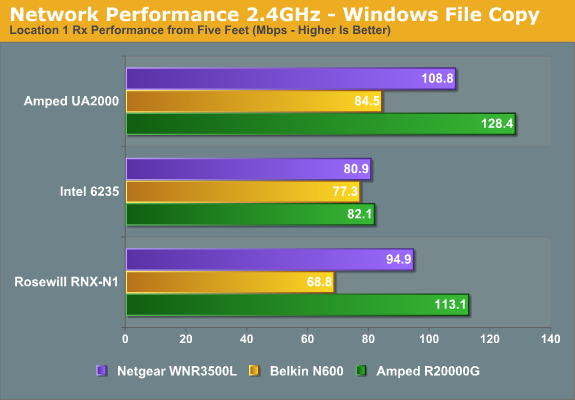

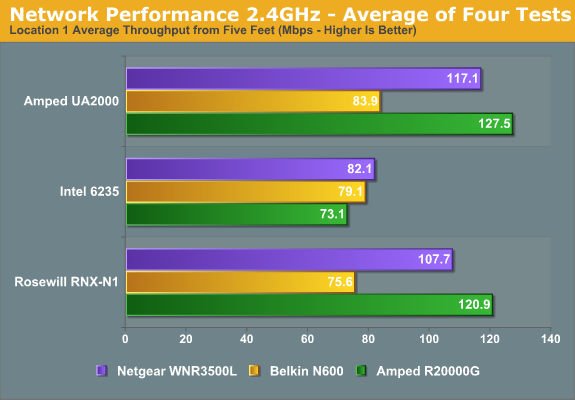
Using the 2.4GHz spectrum, things don’t quite fall out as the RSSI numbers would lead us to expect. On the router side of things, the R20000G typically at least matches the other two routers or takes an outright lead, regardless of which adapter we use. There are two exceptions: one is in the NTttcp Tx speed with the Rosewill adapter, where the Netgear actually comes out ahead; the second is that the Intel 6235 adapter has relatively poor rates for both Tx tests with the R20000G.
Looking at the average performance for all four tests, the R20000G is the fastest router with two of the adapters and the slowest when paired with the Intel 6235 (though that’s caused by the low Tx rates, as Rx rates are actually slightly higher than with the other two routers). Across the three adapters, the R20000G leads the Netgear by just 5% but takes a more significant 35% lead over the Belkin router.
There’s another interesting piece of information with the routers, and that’s the performance of the Belkin N600. Despite being capable of up to 300Mbps, the best result with the three adapters is only around 85Mbps. The reason appears to be related to the use of 40MHz channels; Belkin’s router is more neighbor friendly, so the presence of other (generally weak) 2.4GHz wireless signals causes the router to default to a 20MHz only channel (144Mbps max), and 85Mbps is roughly 60% utilization (about the most we usually see in practice with wireless networking).
Comparing the three adapters, Amped’s UA2000 again leads in most of the tests, often by a sizeable margin. The one test case where it comes in second is NTttcp Rx speed, where the lowly Rosewill adapter manages to score a win when paired up with the R20000G. In the other test cases, the UA2000 is at least as fast as the next closest adapter, with up to twice the throughput of the Intel 6235 on the Tx testing. There’s no equivocating necessary this time: the UA2000 delivers better average performance across our three test routers. It’s 8% faster than the Rosewill adapter (which incidentally also uses a Ralink chipset) and 40% faster than the Intel 6235. On a similar note to the Belkin router, it also appears that Intel’s 6235 drivers are more neighbor friendly, as the 6235 never locked onto a 40MHz connection even in our best-case test scenario. Now let’s see what happens with a 5GHz connection.
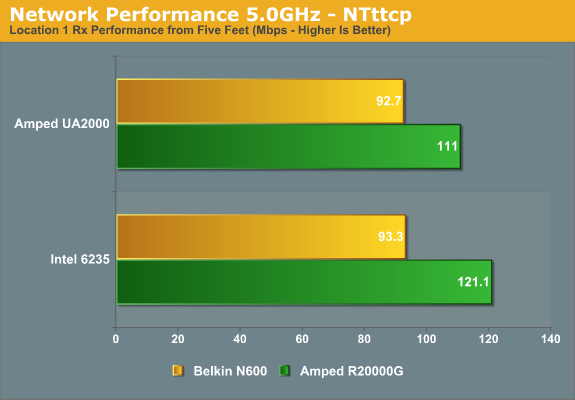
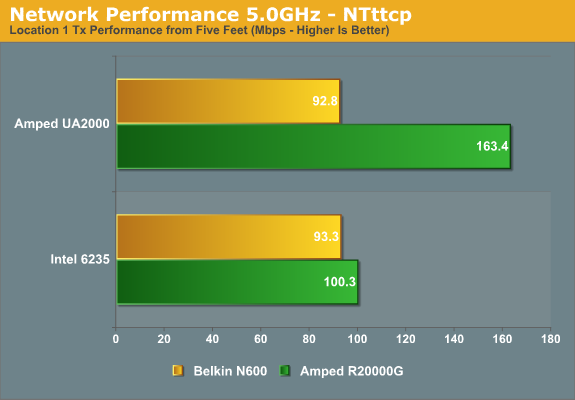
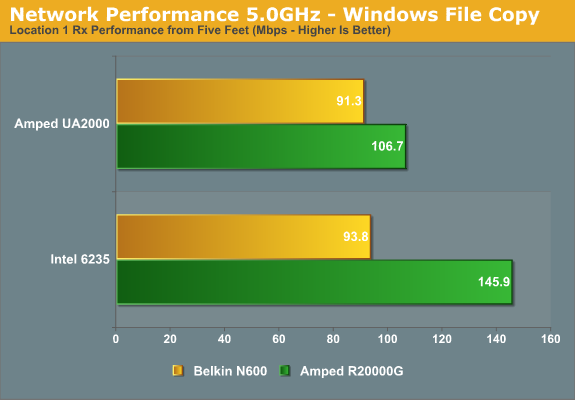
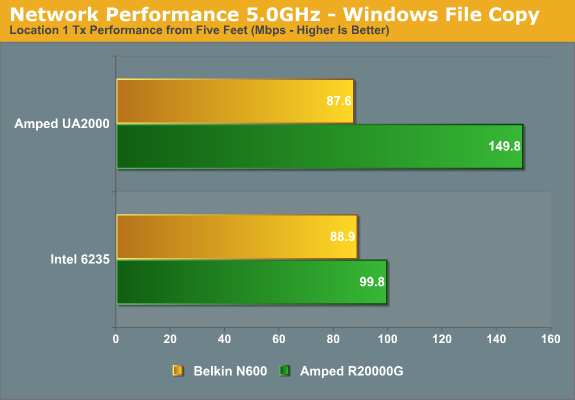
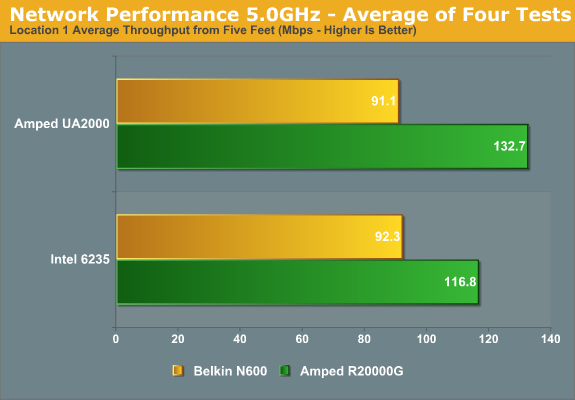
This time we only have two routers and two adapters to look at, since the Netgear router and Rosewill adapter are both limited to 2.4GHz operation. Looking at the router results, again the R20000G takes a healthy lead over the Belkin router, leading in throughput by anywhere from 7.5% (NTttcp Tx with the Intel 6235) to as much as 75% (NTttcp Tx with the UA2000). On average, the R20000G delivers 35% better throughput compared to the Belkin N600—45% better using the UA2000, or 26% better with the Intel 6235. The Belkin also does connect with 40MHz channels this time, but even with the wider bandwidth allotment, performance never quite makes it up to 100Mb Ethernet speeds, indicating Belkin’s router isn’t one of the best offerings out there. Obviously, we’re only dealing with one point of comparison and I expect some of the better routers out there (ASUS RT-N66U, Apple Airport Extreme, Linksys E4200, etc.) would deliver comparable if not better performance, particularly when teamed up with a 3x3:3 MIMO adapter. Still, the R20000G delivers very good throughput for close proximity connections.
Switching over to the adapter comparisons, the UA2000 appears to be running into bottlenecks with the Belkin router, resulting in performance that’s basically tied with the Intel 6235. Of note is that where the Intel 6235 refused to use a 40MHz connection on 2.4GHz, it’s more than happy to grab a 300Mbps connection this time. When we shift over to the R20000G, we get two different stories. On the one hand, the UA2000 has Tx rates that are 50-65% faster than the Intel 6235, which is impressive; what’s not so impressive is that Intel turns the tables on Rx rates and leads the UA2000 by 10-35%. I’m not sure which one would be more important for me in practice, but I’d probably err in favor of Rx rates, as I’m more likely to be copying/receiving large amounts of data over the network as opposed to sending/transmitting data. (As an example, I could be streaming a movie from a NAS or similar system to my laptop, but I typically wouldn’t be sending a movie back to the NAS/server.) Average throughput across all four tests still favors the UA2000 over the 6235 by 14%, but the better Rx rates with 6235 makes this more of a tossup.










28 Comments
View All Comments
Conficio - Sunday, June 24, 2012 - link
I wonder why Amped Wireless would not combine the repeater and the directional antenna. As Jarred mentioned, for a mobile device a directional antenna is a bit inconvenient, especially if it does easily move.However for a repeater it would be ideal. Place your repeater in a quite weak spot and use the power of the directional antenna to still get a good signal. Then broadcast the repeated signal onmi-directional. That should cut down on the interference too. And a repeater is a heavier object to begin with and stationary. Sure if you don't need it, then you won't need it. But if you have a tricky situation, or simply a very large property (lets say a boats house or an artists shed) then this should be a great solution.
Even better would be to add an additional directional antenna to the main router and the ability to use different channels for the directional link. That could make a point to point link that would cut down on interference even more.
JarredWalton - Sunday, June 24, 2012 - link
I believe Amped does support this, though you'd need to provide the antennas yourself (Amped sells them, though). The only problem is that you'd basically have one antenna directional and pointed at the router with the second omnidirectional, so your total omnidirectional signal strength would likely be limited.Conficio - Monday, June 25, 2012 - link
Thanks Jarred for clarifying this.In my mind that poses one more question, is the directional USB stick a 2x2 config? are both antennas directional? Or is it only one antenna?
But I think you are right, just replacing an antenna with a directional one is not the same as building a real repeter that has a separate notion of (set of) input antenna (directional) and set of output antenna (omnidirectional). Hence there is the opportunity for a company like Amped.
Another question. Is it possible to use only one band (5GHz) to talk to the router and the other band (2.4 GHz) to redistribute? The same for channels? Which should get down the interference even better.
JarredWalton - Monday, June 25, 2012 - link
AFAIK, the UA2000 has both antennas pointing the same direction. It can also pick up other routers that aren't being pointed at, but range and performance drop considerably.As for routing one band to the router and the other for talking to devices, I asked Amped about this, and they said while in theory it's possible to have the repeater send wireless traffic over the other connection (when present), they chose not to do it this way to "keep things simple" or something. If you use a 2.4GHz only router (or disable the 5GHz channel), then 5GHz traffic will get routed over the 2.4GHz radio; likewise, you could disable your router's 2.4GHz channel and have the repeater's 2.4GHz traffic route over 5GHz. That might actually be interesting to test out.
mike8675309 - Tuesday, June 26, 2012 - link
I actually do that in my home. Using DD-WRT I have a WDS network setup with 3 dual radio routers. Clients connect on the 2.4GHz antennas and the routers talk to each other over the 5GHz antennas.PS3, Xbox, Dish DVRs connect with ethernet and get a 5Ghz connection to the internet router, perfect for streaming from Netflix or Dish.
This eliminates the issue with 1/2 the bandwidth when using the same radio to talk to clients as you use for repeating to the main router, which is what is happening for most repeaters in the market.
tlcqualityrentals - Tuesday, July 3, 2012 - link
Lots of great information on this site. If only I could figure out what you guys are talking about. LOL. I had narrowed down my selection to the Amped Wireless R20000g to replace my years 5+ year old Linksys router/modem. The Linksys was fine for my home. I have recently added a cottage and a pavilion to my property. Both are approximately 300 to 400 feet from the Linkysys router. It is imperative that i provide good network coverage in the cottage. My question to you is, how would you solve this issue? What items would you buy?Thanks for any suggestions.
Much appreciated.
Rhonda
bman212121 - Monday, June 25, 2012 - link
One of the biggest issues when trying to pick a wireless AP for range is dechipering through all of the claimed power ratings. I bought an AP that was listed as having a 400mW power rating. I figured that meant that it was a 200mW radio output and 200mW for the 3dbi antennas on it. That is technically true but the issue with N is that those numbers are also divided by the number of antennas you have. So in reality it was 100mW per amp with 100mW (3dbi gain) for each antenna.So in the case of this amped wireless device it would be 125mW (21Db) amps and 5dbi antennas (26dbi EIRP per antenna, making 29dbi total power output) This would make it slightly more powerful than the average home router but for devices where you can replace the antennas you will get more power by having bigger antennas than what is provided on this device.
Case in point, I was floored when our old Linksys WRT54G actually out ranged my 400mw N access point because it used the same 100mw (20Dbm) output and a 2dbi antenna. I'm guessing it must have had a slightly better method of determining the best path and probably a bit more sensitive receiver. I was already planning on swapping the antennas with 9dbi rubber duckies. Once I did that then my AP was able to travel farther however location seems to be far more important for range than anything you can do on the AP side.
GullLars - Sunday, July 8, 2012 - link
"If I had been wise, I would have tabulated all the individual results and come up with a throughput distribution graph (similar to what Brian does with our smartphone Speedtest results), but unfortunately I only considered doing that after the fact. It would also become rather difficult to compare results between routers and adapters using such charts. Still, if there’s enough desire for such testing, I can revisit the subject with a smaller article. Either leave a comment or drop me an email if you’re interested in such testing."Yes, when there are very variable results, using result distribution graphs can give very important information averages leave out, like best and worst case, and consistency of performance.
I'd rather have a wireless connection at average 80Mbps ±10Mbps than average 140Mbps with drops to 40Mbps 10% of the time. Especially if this is also reflected in latency. I'm kinda surprised there were no meassuring of ping, just throughput. Ping and ping spikes are very important for how it feels to use wireless connections.
For most rewiews of IO devices there is mention of both throughput and latency, why not also do this for wireless?